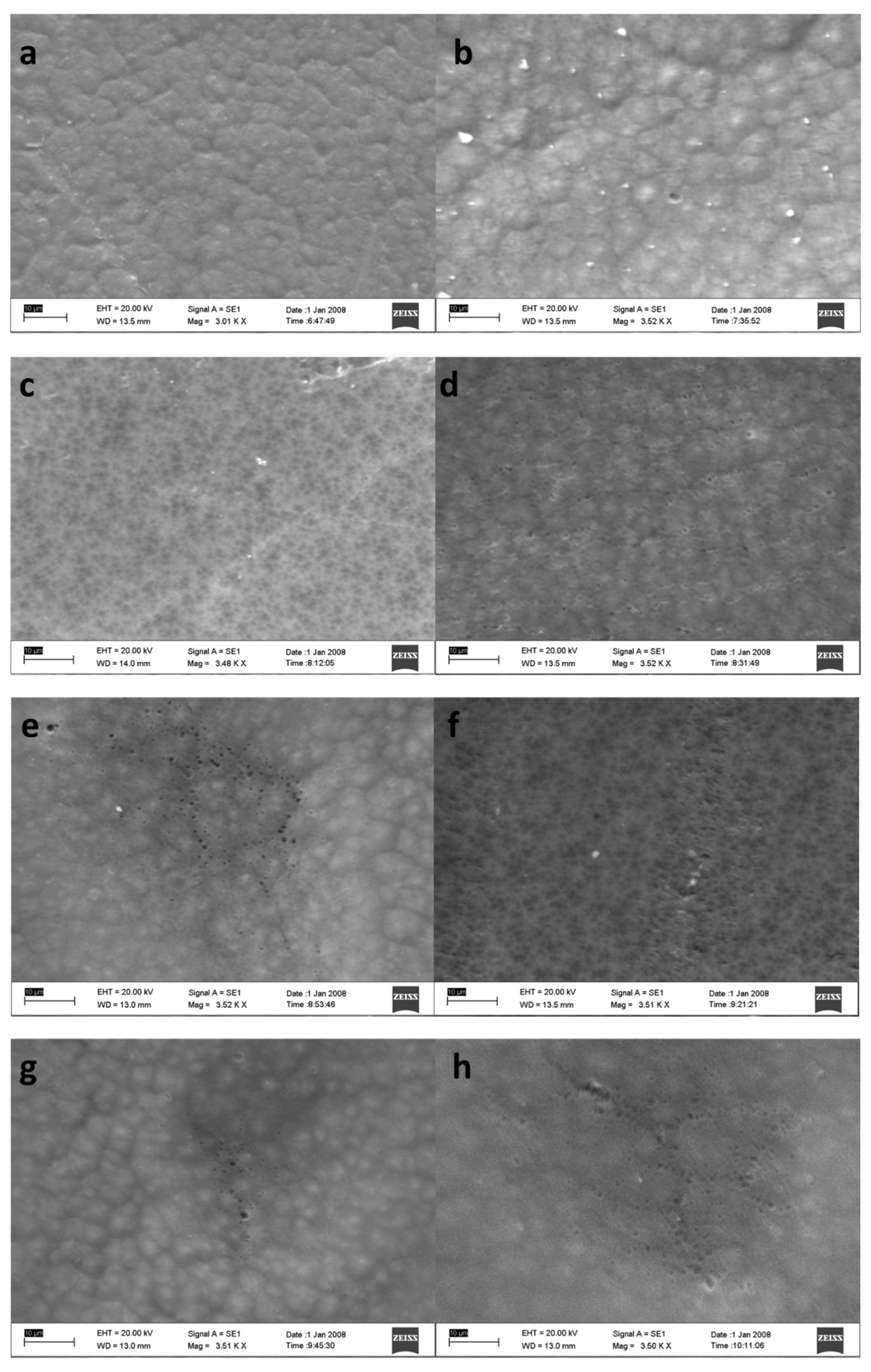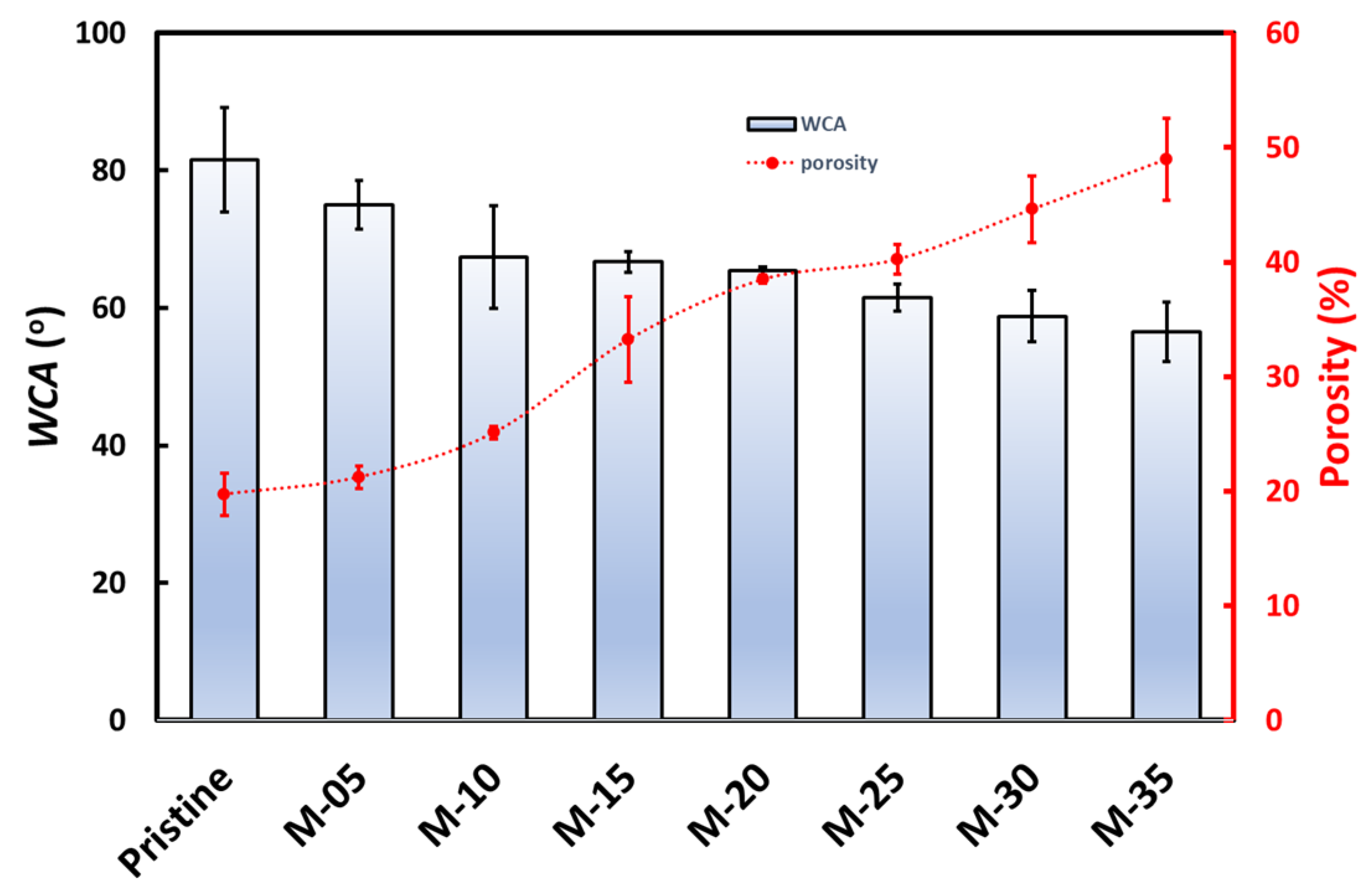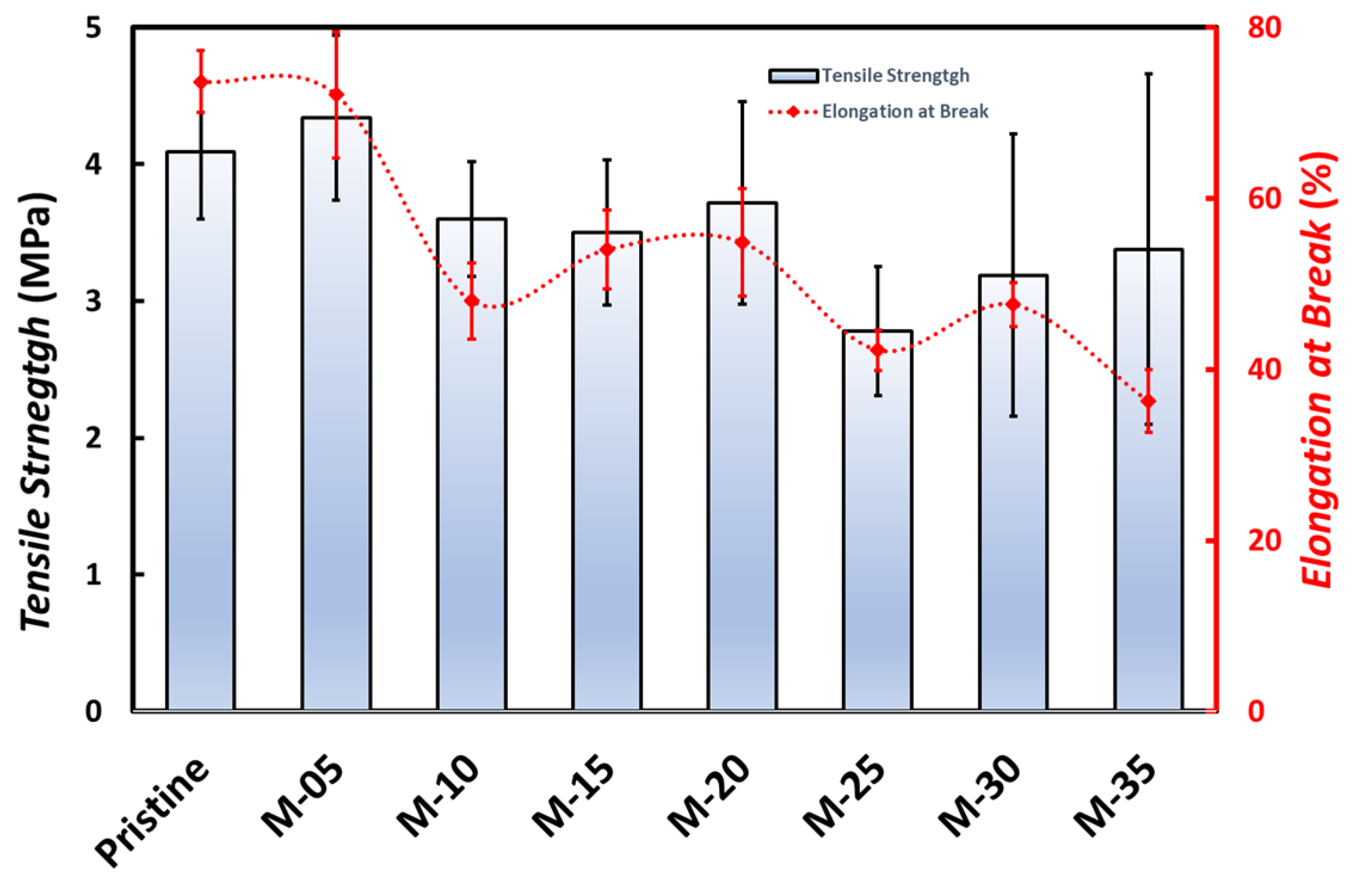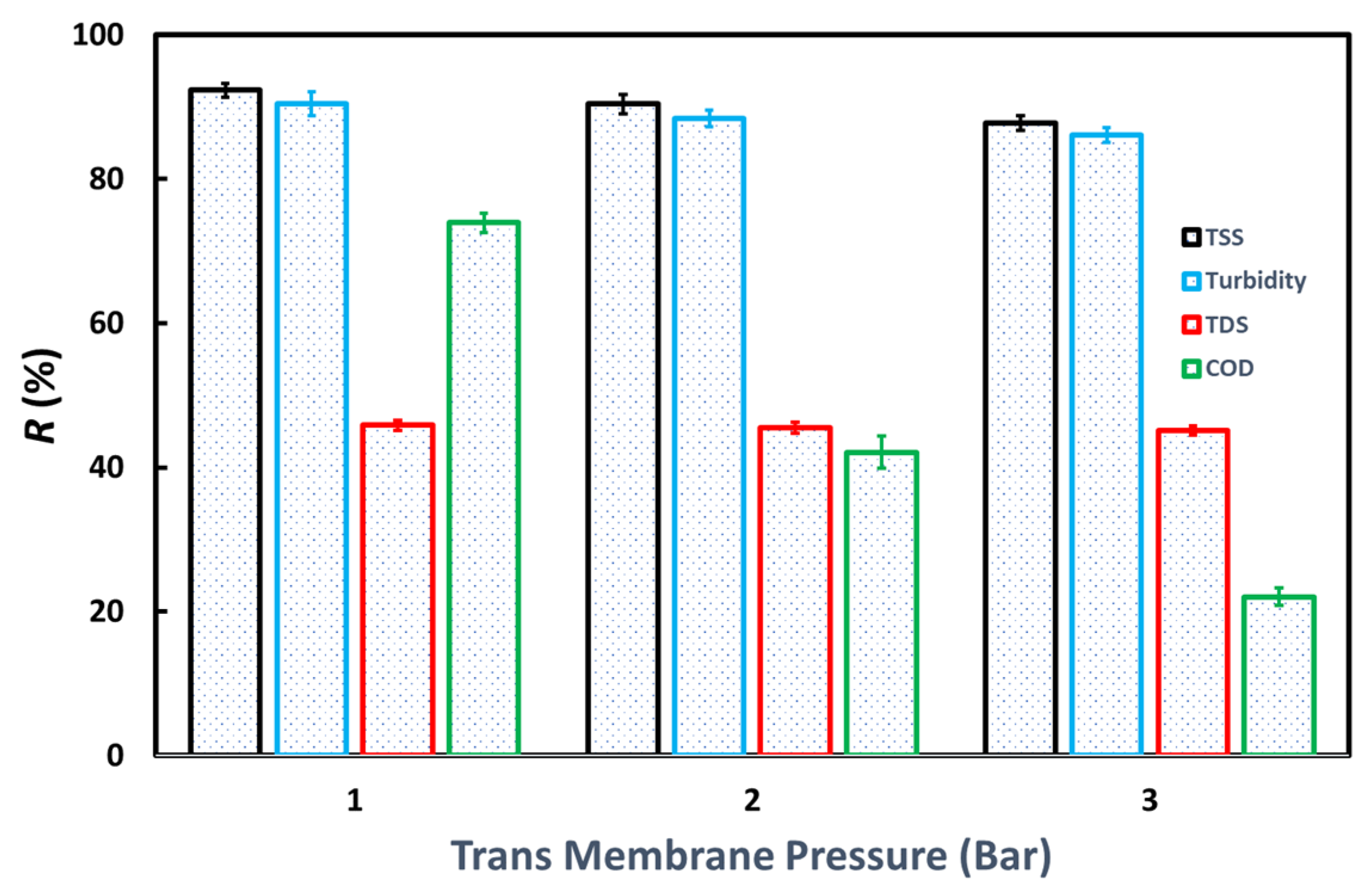Preparation of PVDF-PVP Composite Membranes for Oily Wastewater Treatment
Abstract
:1. Introduction
2. Materials and Methods
2.1. Membrane Preparation
2.2. Membrane Characterization
2.3. Pretreatment of Oily Wastewater
2.4. Ultrafiltration Test
3. Results and Discussion
3.1. Membrane Characterization
3.2. Oily Wastewater Treatment
4. Conclusions
Author Contributions
Funding
Data Availability Statement
Acknowledgments
Conflicts of Interest
References
- Doraisammy, V.; Lai, G.S.; Kartohardjono, S.; Lau, W.J.; Chong, K.C.; Lai, S.O.; Hasbullah, H.; Ismail, A.F. Synthesis and characterization of mixed matrix membranes incorporated with hydrous manganese oxide nanoparticles for highly concentrated oily solution treatment. Can. J. Chem. Eng. 2018, 96, 1612–1619. [Google Scholar] [CrossRef]
- Wang, T.; Xing, L.; Qu, M.; Pan, Y.; Liu, C.; Shen, C.; Liu, X. Superhydrophobic polycarbonate blend monolith with micro/nano porous structure for selective oil/water separation. Polymer 2022, 253, 124994. [Google Scholar] [CrossRef]
- Zhang, M.; Su, M.; Qin, Y.; Liu, C.; Shen, C.; Ma, J.; Liu, X. Photothermal ultra-high molecular weight polyethylene/MXene aerogel for crude oil adsorption and water evaporation. 2D Mater. 2023, 10, 024007. [Google Scholar] [CrossRef]
- Wang, S.-K.; Wang, X.; Tian, Y.-T.; Cui, Y.-H. Nutrient recovery from tofu whey wastewater for the economical production of docosahexaenoic acid by Schizochytrium sp. S31. Sci. Total Environ. 2020, 710, 136448. [Google Scholar] [CrossRef]
- Oktariany, A.; Kartohardjono, S. Effect of coagulant dosage on tofu industry wastewater treatment in combination with ultrafiltration process using polysulfone membrane. In Book Effect of Coagulant Dosage on Tofu Industry Wastewater Treatment in Combination with Ultrafiltration Process Using Polysulfone Membrane, 2018 ed.; EDP Sciences: Les Ulis, France, 2018; p. 04004. [Google Scholar]
- Purnawan, I.; Febriasari, A.; Setyaputra, B.; Yolandini, T.T.; Windriyo, M.J.; Karamah, E.F.; Kartohardjono, S. Combined Process of Ozonation and Membrane Processes to treat Wastewater from Batik Industry. In Book Combined Process of Ozonation and Membrane Processes to Treat Wastewater from Batik Industry, 2020 ed.; IOP Publishing: Bristol, UK, 2020; p. 012003. [Google Scholar]
- Shi, X.; Zuo, J.; Zhang, M.; Wang, Y.; Yu, H.; Li, B. Enhanced biogas production and in situ ammonia recovery from food waste using a gas-membrane absorption anaerobic reactor. Bioresour. Technol. 2019, 292, 121864. [Google Scholar] [CrossRef] [PubMed]
- Febriasari, A.; Purnawan, I.; Chalid, M.; Ismojo, I.; Kartohardjono, S. A Direct Comparison Between Poly (vinylidene) Flouride and Polysulfone Flat Sheet Membrane; Characterization and Mechanical Strength. In Book a Direct Comparison between Poly (Vinylidene) Flouride and Polysulfone Flat Sheet Membrane; Characterization and Mechanical Strength, 2020 ed.; IOP Publishing: Bristol, UK, 2020; p. 012002. [Google Scholar]
- Barambu, N.U.; Bilad, M.R.; Bustam, M.A.; Kurnia, K.A.; Othman, M.H.D.; Nordin, N.A.H.M. Development of membrane material for oily wastewater treatment: A review. Ain Shams Eng. J. 2021, 12, 1361–1374. [Google Scholar] [CrossRef]
- Zheng, H.; Wang, D.; Sun, X.; Jiang, S.; Liu, Y.; Zhang, D.; Zhang, L. Surface modified by green synthetic of Cu-MOF-74 to improve the anti-biofouling properties of PVDF membranes. Chem. Eng. J. 2021, 411, 128524. [Google Scholar] [CrossRef]
- Thakur, V.K.; Voicu, S.I. Recent advances in cellulose and chitosan based membranes for water purification: A concise review. Carbohydr. Polym. 2016, 146, 148–165. [Google Scholar] [CrossRef]
- Huang, F.Y.; Arning, A. Performance comparison between polyvinylidene fluoride and polytetrafluoroethylene hollow fiber membranes for direct contact membrane distillation. Membranes 2019, 9, 52. [Google Scholar] [CrossRef] [Green Version]
- Yeow, M.; Liu, Y.; Li, K. Isothermal phase diagrams and phase-inversion behavior of poly (vinylidene fluoride)/solvents/additives/water systems. J. Appl. Polym. Sci. 2003, 90, 2150–2155. [Google Scholar] [CrossRef]
- Liu, F.; Hashim, N.A.; Liu, Y.; Abed, M.R.M.; Li, K. Progress in the production and modification of PVDF membranes. J. Membr. Sci. 2011, 375, 1–27. [Google Scholar] [CrossRef]
- Purnawan, I.; Angputra, D.; Debora, S.C.; Karamah, E.F.; Febriasari, A.; Kartohardjono, S. Polyvinylidene Fluoride Membrane with a Polyvinylpyrrolidone Additive for Tofu Industrial Wastewater Treatment in Combination with the Coagulation–Flocculation Process. Membranes 2021, 11, 948. [Google Scholar] [CrossRef]
- Muchtar, S.; Wahab, M.; Mulyati, S.; Riza, M.; Arahman, N. Deposition of polydopamine on the surface of Polyvinylidene Fluoride (PVDF) membrane as A UV-Shielding layer. In Book Deposition of Polydopamine on the Surface of Polyvinylidene Fluoride (PVDF) Membrane as A UV-Shielding Layer, 2019 ed.; IOP Publishing: Bristol, UK, 2019; p. 012017. [Google Scholar]
- Sinsinwar, R.S.; Verma, M. Analysis of pH Value of Water for Treatment Plant of Kekri and Surajpura (Rajasthan) India. Joint J. Nov. Carbon Resour. Sci. Green Asia Strategy 2023, 10, 324–332. [Google Scholar]
- Febriasari, A.; Ananto, A.H.; Suhartini, M.; Kartohardjono, S. Polysulfone–polyvinyl pyrrolidone blend polymer composite membranes for batik industrial wastewater treatment. Membranes 2021, 11, 66. [Google Scholar] [CrossRef]
- Vasin, S.; Filippov, A. Hydrodynamic Permeability of the Membrane as a System of Rigid Particles Covered with Porous Layer (Cell Model). Colloid J. 2004, 66, 266–270. [Google Scholar] [CrossRef]
- Pan, L.; Chen, Y.; Chen, D.; Dong, Y.; Zhang, Z.; Long, Y. Oil removal in tight-emulsified petroleum waste water by flocculation. In Book Oil Removal in Tight-Emulsified Petroleum Waste Water by Flocculation, 2018 ed.; IOP Publishing: Bristol, UK, 2018; p. 042005. [Google Scholar]
- Van Tran, T.T.; Kumar, S.R.; Lue, S.J. Separation mechanisms of binary dye mixtures using a PVDF ultrafiltration membrane: Donnan effect and intermolecular interaction. J. Membr. Sci. 2019, 575, 38–49. [Google Scholar] [CrossRef]
- Wang, Z.; Yu, H.; Xia, J.; Zhang, F.; Li, F.; Xia, Y.; Li, Y. Novel GO-blended PVDF ultrafiltration membranes. Desalination 2012, 299, 50–54. [Google Scholar] [CrossRef]
- Borodko, Y.; Habas, S.E.; Koebel, M.; Yang, P.; Frei, H.; Somorjai, G.A. Probing the Interaction of Poly (vinylpyrrolidone) with Platinum Nanocrystals by UV−Raman and FTIR. J. Phys. Chem. B 2006, 110, 23052–23059. [Google Scholar] [CrossRef]
- Aili, D.; Kraglund, M.R.; Tavacoli, J.; Chatzichristodoulou, C.; Jensen, J.O. Polysulfone-polyvinylpyrrolidone blend membranes as electrolytes in alkaline water electrolysis. J. Membr. Sci. 2020, 598, 117674. [Google Scholar] [CrossRef]
- Ohya, H.; Shiki, S.; Kawakami, H. Fabrication study of polysulfone hollow-fiber microfiltration membranes: Optimal dope viscosity for nucleation and growth. J. Membr. Sci. 2009, 326, 293–302. [Google Scholar] [CrossRef]
- Deng, B.; Li, J.; Hou, Z.; Yao, S.; Shi, L.; Liang, G.; Sheng, K. Microfiltration membranes prepared from polyethersulfone powder grafted with acrylic acid by simultaneous irradiation and their pH dependence. Radiat. Phys. Chem. 2008, 77, 898–906. [Google Scholar] [CrossRef]
- Shang, W.; Tiraferri, A.; He, Q.; Li, N.; Chang, H.; Liu, C.; Liu, B. Reuse of shale gas flowback and produced water: Effects of coagulation and adsorption on ultrafiltration, reverse osmosis combined process. Sci. Total Environ. 2019, 689, 47–56. [Google Scholar] [CrossRef] [PubMed]
- Mohamed, H.O.; Obaid, M.; Khalil, K.A.; Barakat, N.A. Power generation from unconditioned industrial wastewaters using commercial membranes-based microbial fuel cells. Int. J. Hydrogen Energy 2016, 41, 4251–4263. [Google Scholar] [CrossRef]








| Parameter | Value |
|---|---|
| TSS (mg/L) | 194 ± 3.3 |
| Turbidity (NTU) | 185 + 3.5 |
| TDS (mg/L) | 10,280 ± 681 |
| COD (mg/L) | 99,216 ± 7071 |
| pH | 7.1 ± 0.2 |
| Parameter | Before Pretreatment | After Pretreatment |
|---|---|---|
| TSS (mg/L) | 194 ± 3.3 | 52 ± 0.9 |
| Turbidity (NTU) | 185 + 3.5 | 48 ± 0.9 |
| TDS (mg/L) | 10,280 ± 681 | 9780 ± 648 |
| COD (mg/L) | 99,216 ± 7071 | 98,875 ± 5290 |
| pH | 7.1 ± 0.2 | 6.2 ± 0.2 |
Disclaimer/Publisher’s Note: The statements, opinions and data contained in all publications are solely those of the individual author(s) and contributor(s) and not of MDPI and/or the editor(s). MDPI and/or the editor(s) disclaim responsibility for any injury to people or property resulting from any ideas, methods, instructions or products referred to in the content. |
© 2023 by the authors. Licensee MDPI, Basel, Switzerland. This article is an open access article distributed under the terms and conditions of the Creative Commons Attribution (CC BY) license (https://creativecommons.org/licenses/by/4.0/).
Share and Cite
Kartohardjono, S.; Salsabila, G.M.K.; Ramadhani, A.; Purnawan, I.; Lau, W.J. Preparation of PVDF-PVP Composite Membranes for Oily Wastewater Treatment. Membranes 2023, 13, 611. https://doi.org/10.3390/membranes13060611
Kartohardjono S, Salsabila GMK, Ramadhani A, Purnawan I, Lau WJ. Preparation of PVDF-PVP Composite Membranes for Oily Wastewater Treatment. Membranes. 2023; 13(6):611. https://doi.org/10.3390/membranes13060611
Chicago/Turabian StyleKartohardjono, Sutrasno, Ghofira Muna Khansa Salsabila, Azzahra Ramadhani, Irfan Purnawan, and Woei Jye Lau. 2023. "Preparation of PVDF-PVP Composite Membranes for Oily Wastewater Treatment" Membranes 13, no. 6: 611. https://doi.org/10.3390/membranes13060611






